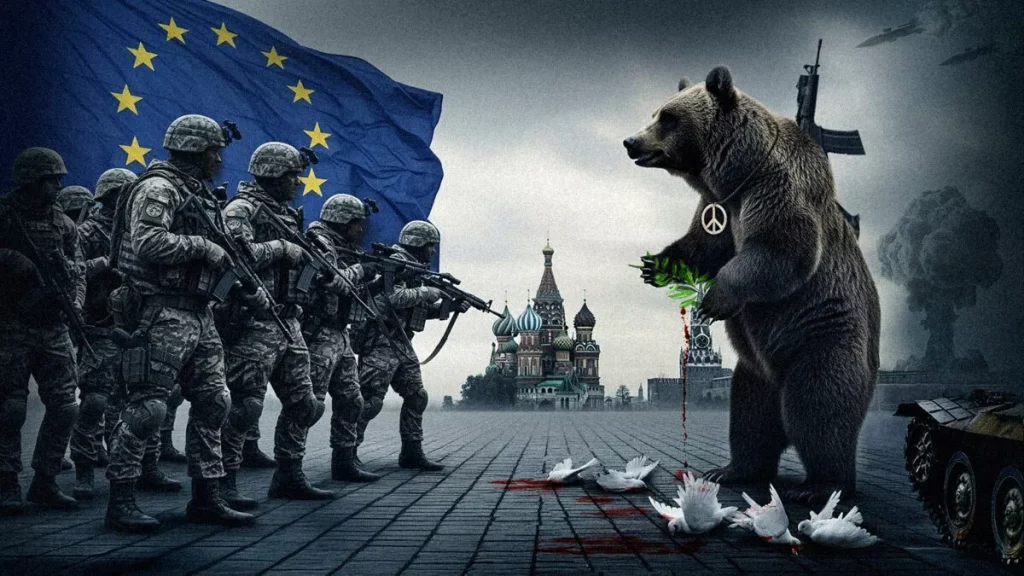Moscow pays lip service to peace, yet its disinformation peddlers talk constantly of war. This is no accident. Portraying European defence as ‘aggressive militarisation’ and support for Ukraine as ‘warmongering’ is a manipulative attempt to create a skewed reality. Euvdisinfo inform.
A few weeks ago, it was NATO defence spending(opens in a new tab) which found itself in the Kremlin’s disinformation crosshairs. Now, Moscow’s manipulative gaze has turned to Europe, as the Kremlin set out to look for new imaginary external enemies to justify Russia’s revanchist and imperialist worldview.
Russia painted Europe as the new ‘baddie’ already in the immediate aftermath of the NATO Summit in The Hague, but in the weeks since, the pro-Kremlin disinformation ecosystem has pulled out all stops to depict Europe, particularly Germany and France, as its Enemy No. 1. To be fair, Russia still harbours immense distaste for NATO, but now, increasingly, it’s the European allies of the transatlantic Alliance drawing the Kremlin’s ire(opens in a new tab).
A lot of war talk for someone wanting peace
As part of Russia’s war against Ukraine, the Kremlin has been paying lip service to peace for months, including peddling Moscow’s imperialist ideas(opens in a new tab) at the BRICS Summit in Brazil. Of course, it is all baloney, but we have kept track of the Kremlin’s strange ideas for peace. Whether it is laying down impossible conditions or spinning distractions about ‘root causes’, the Kremlin will find a hundred ways to say No! to peace, because Russia wants war, not peace.
And if we look at the prevailing narratives in the pro-Kremlin disinformation ecosystem, it becomes evident that any talk of peace is merely a subterfuge, because there is one theme that dominates the pro-Kremlin aether above all – war.
For example, recently, Russian state-controlled TV and radio is full of speculation about Europe allegedly preparing to attack Russia(opens in a new tab). This takes many forms, from claiming that with the US allegedly losing interest(opens in a new tab), Europe will take over using Ukraine as a battering ram against Russia(opens in a new tab), to pondering what resources Europe can mobilise against Russia(opens in a new tab). The goal here is quite evident: conjure the spectre of an external enemy by depicting European defence initiatives(opens in a new tab) as ‘aggressive militarisation(opens in a new tab)’ and EU support for Ukraine(opens in a new tab) as ‘warmongering’, to persuade your audiences that the only way forward is the Kremlin’s way.
Fine line between fear and reassurance
Admittedly, claiming that Russia is no threat but the evil Europeans lust for war anyway(opens in a new tab) can stoke too much anxiety. So the Kremlin’s disinformation launderers had to walk the fine line between stoking fears and ridiculing the European defence efforts to maintain the carefully crafted faux image of Russia’s unassailability.
So, combined with absurd claims that sanctions made the Russian economy stronger, the pro-Kremlin manipulation machinery also churned out stories of feigned worry that increased defence spending will lead to NATO’s collapse, or that the Western economies won’t be able to sustain the debts,(opens in a new tab) or even that the military spending will undo the very social fabric of Europe. But this is merely self-assured chest-thumping on Moscow’s part, because in reality, the EU is one of the world’s largest and most versatile economies, with a combined GDP of some 17 trillion euros, roughly eight times that of Russia.
Ever the humanitarian
There is another facet of the Kremlin’s manipulative peace rhetoric that makes a regular appearance in state-scrutinised editorial guidelines – known as a temnik – for the pro-Kremlin disinformation mouthpieces. That is to depict Russia as a great benevolent humanitarian state that fights against oppression and inequality wherever it can find it. Whether it’s telling tall tales about alleged genocide in Donbas or battling against the spectre of ‘Russophobia’ plaguing Europe, in its own view, Russia is always the knight in shining armour.
The most recent example to fuel the fairy tale of ‘humanitarian Russia’ was a report on ‘human rights in certain countries’(opens in a new tab), fed into the pro-Kremlin disinformation ecosystem by the Russian Foreign Ministry. The goal here is likely two-fold. First, to prop up the image of Russia as the great humanitarian and sustain the pro-Kremlin myth of a rebirth of Nazism in Europe, which is an integral part of the ideological foundation supporting Russia’s war against Ukraine.
Second, to distract from the deplorable lack of freedoms(opens in a new tab) and the constant persecution of any civic action threatening the Kremlin’s monopoly on power. You need not look further than the recent decimation of the independent elections observer Golos(opens in a new tab) to see how truly humanitarian Russia really is.
Some pro-Kremlin spin doctors went as far as to even claim that the UN has confirmed the accusation made in the report. Of course the UN has not. That claim is merely a figment of the Kremlin’s imagination, combining equal parts of wishful thinking and manipulative deceit. Don’t be deceived.

